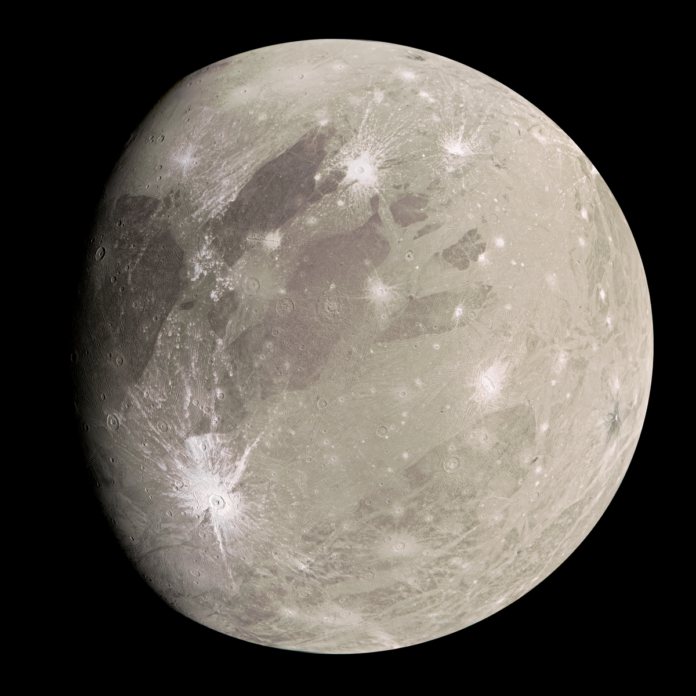Ganymede, Jupiter’s moon, is the largest moon in our Solar System. It’s so enormous that it even surpasses Mercury in size! It’s also twice as large and massive as our own Moon. Following Ganymede, the second-largest moon is Saturn’s moon Titan, which is only 2% smaller than Ganymede.
Intriguing Fact: In 1610, Galileo, using a telescope, discovered four of Jupiter’s moons – Europa, Callisto, Io, and Ganymede. This discovery led to what is now known as the “Galilean moons.” However, there is evidence that a Chinese astronomer, Gan De, in 365 BCE, observed one of Jupiter’s moons before the invention of telescopes.
Most likely, it was Ganymede, as it is visible from Earth without instruments, albeit challenging to discern.
Similar to our Moon and three other moons of Jupiter, Ganymede rotates slowly around Jupiter, always keeping one side facing it. While Ganymede completes one full orbit, another moon, Europa, completes two orbits, and the rapid Io manages four.
Ganymede has an atmosphere, primarily composed of oxygen. However, it is so thin that it is insufficient to sustain Earthly organisms. Its pressure is approximately one million times less than that on our planet, making it nearly indistinguishable from a vacuum. However, Ganymede does have water ice – its reserves are incredibly vast, comprising about 50% of its total mass.
Even more uniquely, Ganymede possesses its own magnetic field – a feature no other moon in the Solar System can boast. This magnetosphere may potentially shield future colonists of this celestial body.
Some scientists speculate that beneath Ganymede’s icy crust lies a true ocean of liquid water. Not just one, but possibly four oceans, arranged in layers beneath the ice. If true, the water in these oceans must be extremely saline to avoid freezing in such harsh conditions.
Ganymede is exceptionally cold, with temperatures ranging from -120 °C to -202 °C. This extreme cold is due to the thinness of its atmosphere. Were it denser, it could induce a greenhouse effect, resulting in higher temperatures. However, scientists believe that within Ganymede’s interior and deep oceans, it could be much warmer due to pressure.
After studying information gathered over many years about Ganymede, planetary scientists have made Interesting Facts and hypotheses:
- The largest moon in the Solar System has roughly the same age as Jupiter and Earth. Moreover, it formed incredibly quickly by cosmic standards – the formation process took only 10,000 years. This is much faster than the usual process for most other large celestial bodies.
- Ganymede has a very low inertial trace among all the planets and moons of the Solar System. This suggests that this moon has significant internal stratification. Besides the accumulation of its four oceans, the largest moon in the Solar System likely has a core with solid and liquid layers.
- Ganymede has its own magnetic field, albeit relatively weak, extending approximately 10-12 thousand kilometers. In contrast, Saturn boasts a powerful magnetic field reaching about a million kilometers. Ganymede’s magnetosphere is almost entirely overlapped by Jupiter’s magnetosphere.
- Like Earth and Mars, Ganymede has polar caps, likely consisting primarily of water snow. Initially resembling frost, over billions of years, massive accumulations of snow and ice have formed.
- Ganymede’s surface is a mixture of two types of terrain: heavily cratered regions and grooved terrain. The grooved terrain indicates tectonic activity and suggests that Ganymede has experienced geological processes, possibly including plate tectonics, in its past.
- Ganymede’s surface is also marked by bright and dark patches, indicating variations in composition. The dark patches are likely made of rocky material, while the bright patches are believed to be composed of ice.
- Ganymede’s magnetic field interacts with Jupiter’s magnetosphere, creating powerful auroras near the moon’s poles. These auroras are caused by charged particles from Jupiter’s magnetosphere becoming trapped in Ganymede’s magnetic field and colliding with its atmosphere.
- Ganymede has a thin exosphere composed mostly of oxygen, as well as trace amounts of hydrogen and other elements. This exosphere is constantly replenished by the sputtering of surface materials caused by the bombardment of energetic particles from Jupiter’s magnetosphere.
- Ganymede’s unique combination of a magnetic field, subsurface oceans, and potentially habitable environments has led scientists to speculate about the possibility of life on the moon. While no direct evidence of life has been found, Ganymede remains an intriguing target for future exploration missions aimed at searching for signs of habitability.
